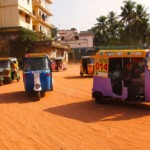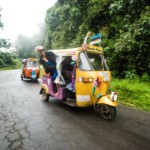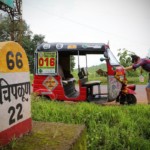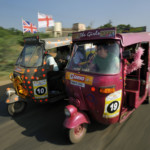Often called the Moon City, Thiruvannamalai is a humble, pilgrimage town in the Indian state of Tamil Nadu. Every month at the full moon thousands of pilgrims gather to circumnavigate the base of the Arunachala Mountain, approximately 14 km in circumference, where Shiva is honored as Arunachaleswar. Thiruvannamalai is one of the Pancha Butha Sthalangal, or rather one of the places where God appeared glorified in the form of an element, namely fire. Traveling to Tiruvannamalai is a spiritual journey filled with destiny and often leaves visitors physically, mentally and emotionally inspired. Many records date it as a pilgrimage site as far back as 150 BC.
Not only is the red mountain Arunachala a significant factor in the spirituality connected with this site but also the construction of the Arunachal temple. The temple is the center of Thiruvannamalai’s octagonal formation and in strict observance with sacred geometry. The ancient Tamils or Dravidas were very observant of mathematical repetition in natural patterns, and sought to include them in the proportions of the temple. The shape of the temple and its situation magnifies the energies of its surroundings.
For thousands of years sadhus (spiritual men), priestesses, pilgrims and gurus have come in search of answers and enlightenment at Thiruvannamalai. Their dancing, praying, and chanting have continued to charge the Arunachala hill and town with energies of peace, love, healing, and divinity. Many famous gurus have established ashrams here including Advaita Vendanta guru Ramana Maharshi as well as Seshadri Swamigal and RamSurat Kumar. But even more famous is the Deepam festival held here every year and is celebrated over a period of 13 days. The first 3 days of the procession take place at the Durga Temple and the remaining days are celebrated in the Annamalai temple.
Places of Interest
Arunachala Temple — Also known as Annaamalai, this famous shrine of Tamil Nadu is a living symbol of ancient Tamil architecture. There are 11 levels to the temple and it stands at 217 feet with 4 separate tower entrances penetrating the formidable walls. The hall contains 1000 pillars and while crumbling a bit this cavernous wonder is the essence of Dravidian architecture. On each pillar can be seen scenes of battling horsemen, dancing girls, lions, and images of Ganesh.
Bazaar – Within the temple there are shops were some souvenirs can be purchased such as little baskets, beaded necklaces, religious books and prasadams. It is also possible to buy little oil lamps here that can be lit and then are removed by temple staff when they have burned out. Also you can purchase bananas which you can either eat yourself or feed to the elephants, your choice!
Gingee Fort – Originally built during the Chola dynasty in the 9th Century it was later expanded during the Vijayanagar Empire in the 13th Century. This impenetrable citadel was a strategic place for fending off invading armies and became the headquarters for the Gingee Nayakas. Unfortunately, the fort was not strong enough to keep out the French or eventually or rather inevitably the English. The temple within the fort is full of rock sculptures and it is possible to trace the influences of the ruling dynasties of South India by looking at its walls.





